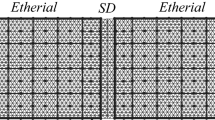Abstract
In this paper, the combined finite-discrete element method (FDEM) has been applied to analyze the deformation of anisotropic geomaterials. In the most general case geomaterials are both non-homogeneous and non-isotropic. With the aim of addressing anisotropic material problems, improved 2D FDEM formulations have been developed. These formulations feature the unified hypo-hyper elastic approach combined with a multiplicative decomposition-based selective integration for volumetric and shear deformation modes. This approach is significantly different from the co-rotational formulations typically encountered in finite element codes. Unlike the co-rotational formulation, the multiplicative decomposition-based formulation naturally decomposes deformation into translation, rotation, plastic stretches, elastic stretches, volumetric stretches, shear stretches, etc. This approach can be implemented for a whole family of finite elements from solids to shells and membranes. This novel 2D FDEM based material formulation was designed in such a way that the anisotropic properties of the solid can be specified in a cell by cell basis, therefore enabling the user to seed these anisotropic properties following any type of spatial variation, for example, following a curvilinear path. In addition, due to the selective integration, there are no problems with volumetric or shear locking with any type of finite element employed.

























Similar content being viewed by others
References
Munjiza A (1992) Discrete elements in transient dynamics of fractured media. PhD thesis. Civil Engineering Department, Swansea
Munjiza A, Andrews KRF, White JK (1998) Combined single and smeared crack model in combined finite-discrete element method. Int J Numer Methods Eng 44:41–57
Owen DRJ, Munjiza A, Bicanic N (1992) A finite element-discrete element approach to the simulation of rode blasting problems. Proceedings FEMSA-92, 11th symposium on finite element methods. South Africa, Cape Town, pp 39–59
Xu D, Kaliviotis E, Munjiza A, Avital E, Ji C, Williams J (2013) Large scale simulation of red blood cell aggregation in shear flows. J Biomech 46(11):1810–1817
Lei Z (2011) Combined finite-discrete element methods and its application on impact fracture mechanism of automobile glass. Ph.D thesis, South China University of Technology
Munjiza A, Lei Z, Divic V, Peros B (2013) Fracture and fragmentation of thin shells using the combined finite-discrete element method. Int J Numer Methods Eng 95(6):478–498
Tatone BSA, Lisjak A, Mahabadi OK, Vlachopoulos N. Verification of the implementation of rock-reinforcement elements in numerical analyses based on the hybrid combined finite discrete element method (FDEM). In: Proceedings 49th US rock mechanics/geomechanics symposium. San Francisco, CA-USA
Munjiza A (2004) The combined finite-discrete element method, 1st edn. John Wiley and Sons Ltd, London
Munjiza A, Knight EE, Rougier E (2012) Computational mechanics of discontinua, 1st edn. John Wiley and Sons, London
Elmo D, Stead D (2010) An integrated numerical modeling-discrete fracture network approach applied to the characterization of rock mass strength of naturally fractured pillars. Rock Mech Rock Eng 43:3–19
Lisjak A, Grasselli G (2010) Rock impact modeling using FEM/DEM. In Munjiza A (ed) Discrete element methods: 5th international conference on discrete element methods, London, UK, 25–26 August 2010, pp 269–274
Mahabadi OK, Grasselli G, Munjiza A (2009) Numerical modelling of a Brazilian Disc test of layered rocks using the combined finite-discrete element method. In: Diederichs CS, Grasselli (eds) RockEng09: 3rd Canada-US rock mechanics symposium, Toronto, Canada, 9–15 May 2009, pp 87–88
Rougier E, Knight EE, Broome ST, Sussman A, Munjiza A (2014) Validation of a three-dimensional finite-discrete element method using experimental results of the split hopkinson pressure bar test. Int J Rock Mech Min Sci 70:101–108
Rougier E, Knight EE, Munjiza A, Sussman AJ, Broome ST, Swift RP, Bradley CR (2011) The combined finite-discrete element method applied to the study of rock fracturing behavior in 3D. In: Proceedings of the 45th US rock mechanics/geo-mechanics symposium. San Francisco, CA, June 26–29
Carey JW, Lei Z, Rougier E, Mori H, Viswanathan H (2015) Fracture-permeability behavior of shale. J Unconv Oil Gas Resour 11:27–43
Morris JP, Rubin MB, Block GI, Bonner MP (2006) Simulations of fracture and fragmentation of geologic materials using combined FEM/DEM analysis. Int J Impact Eng 33:463–473
Morris JP, Johnson S (2009) Dynamic simulations of geologic materials using combined FEM/DEM/SPH analysis. Geomech Geoeng 4(1):91–101
Liu GR, Trung NT (2010) Smoothed finite element methods, 1st edn. CRC Press, Boca Raton
Krysl P, Zhu B (2008) Locking-free continuum displacement finite elements with nodal integration. Int J Numer Methods Eng 76:1020–1043
Camacho GT, Ortiz M (1996) Computational modelling of impact damage in brittle materials. Int J Solids Struct 33:2899–2938
Guo Y, Ortiz M, Belytschko T, Repetto EA (2000) Triangular composite finite elements. Int J Numer Methods Eng 47:287–316
Munjiza A, Rougier E, Knight EE (2015) Large strain finite element method: a practical course, 1st edn. John Wiley and Sons, London
Rougier E, Munjiza A (2010) MRCK\(\_3\)D contact detection algorithm. In: Proceedings of fifth international conference on discrete element methods, London, UK
Rougier E, Munjiza A, John NWM (2004) Numerical comparison of some explicit time integration schemes used in DEM, FEM/DEM and molecular dynamics. Int J Numer Methods Eng 61:856–879
Gurtin ME (1981) An introduction to continuum mechanics. Academic Press, New York
Acknowledgments
We thank the Los Alamos National Laboratory LDRD Program (#200140002DR) for the financial support.
Author information
Authors and Affiliations
Corresponding author
Rights and permissions
About this article
Cite this article
Lei, Z., Rougier, E., Knight, E.E. et al. A generalized anisotropic deformation formulation for geomaterials. Comp. Part. Mech. 3, 215–228 (2016). https://doi.org/10.1007/s40571-015-0079-y
Received:
Revised:
Accepted:
Published:
Issue Date:
DOI: https://doi.org/10.1007/s40571-015-0079-y




